
Packaging and Environmental Surcharges
Bite into a burger, container’s basically tissue paper, but hey, the price jumped. I swear, it’s not even about the beef anymore—half the cost is probably the box. If you stare at the receipt long enough, you’ll see it: packaging costs sneak in, hiding behind “inflation” or whatever excuse is trending. “Eco-friendly” labels? Cute, but my wallet’s the one feeling lighter.
Food Packaging Costs Passed to Customers
Nobody ever admits this, but those “free” fry boxes? They’re not free. I’ve seen supplier invoices—clamshells, napkins, sauce cups—each with a price tag. I once cornered a manager about why combos cost more overnight, and he just blurted out, “Packaging’s up 15%.” Not because they want to, but because legal-compliant, leak-proof containers cost more. California bans polystyrene, so now it’s all about more expensive alternatives. Fun.
Chains keep blaming inflation, but let’s be honest—chicken isn’t up 30%. Delivery apps tack on $2-3 for “packaging/handling,” sometimes buried under taxes. I caught a “service charge” for a single sandwich in Manhattan—just because they double-wrapped it. Nobody asked if I wanted that. It’s not just one chain, it’s everywhere.
| Packaging Line Item | Avg. Price Increase (2024-2025) |
|---|---|
| Standard containers | +12–16% |
| Compostable boxes | +22–27% |
| Sauce cups/lids | +5–11% |
Eco-Friendly Fees and Surcharges
The eco-fee shuffle is a joke. Suddenly, there’s a “biodegradable surcharge”—twenty-five or fifty cents, just dropped into the total. I started jotting them down because I couldn’t believe it. Some wraps are “compostable” but shipped from across the world, so the price jumps again. Supposedly, 58% of people say eco-packaging affects where they eat, but nobody asked me if I wanted to pay for it.
Restaurants just blend these “green” costs into the menu, then brag later in marketing emails. I actually asked a franchise owner about rising meal costs. He just shrugged and blamed city council. Regulatory fines for single-use plastics? Restaurants just roll those into “operating expenses,” so fries cost more whether you want the cup or not. Somewhere, some consultant is probably figuring out how much they can get away with before anyone notices.
“We’re saving the planet!” Sure, but my friends complain about sugarcane fiber forks nobody asked for. A 2024 survey said 44% of diners would consider paying more for sustainable packaging—if anyone actually told them. Nobody’s saying where the extra money goes.
Loyalty Programs and Menu Boards

Why does fast food always feel cheap until you look at the receipt? It’s not magic. It’s “rewards” psychology and menu board trickery. I found myself eating there three times last week, and the fries weren’t even good.
How Loyalty Rewards Shift Spending Habits
My points app pings more than my family group chat. Every badge, some streak, like Burger King genuinely cares about my eating habits. A 2023 study (PYMNTS, Paytronix) claims 57% of millennials visit more often after joining loyalty programs. But why does my wallet feel emptier every week? I remember seeing “Free Medium Fries After Five Visits” on the McDonald’s app. I ordered five sandwiches I didn’t even want, just to get the fries. Then the counter reset.
Loyalty isn’t an accident. Harvard Business Review says “Loyalty programs increase customer frequency and spend.” No kidding. Digital coupons steer you away from value items, or the reward only works if you spend $2 more. The upsell is always a large combo. Did I save money? Not really. My nutrition goals? Gone.
I’ve lost count of how many times a “reward” nudged me into buying a full meal instead of a sandwich. Ever notice the reward never works on the seasonal special—the only thing you wanted?
Psychology of Menu Board Design
Ever try to read a drive-thru menu and realize you can’t find the decimals or calories? Happens to me every time. By the end, I just order whatever’s in the biggest picture. That’s not an accident. Menu designers (I met one—he was obsessed with typefaces) use colors and placement to push you toward pricier stuff. “Limited time offers” in bold? That’s to boost sales on the high-margin junk.
I tried to pick the cheapest combo once. Good luck. The value menu was hidden in the corner, dwarfed by giant combo graphics. Dr. Brian Wansink (Cornell) wrote that people pick whatever’s in the middle or default, especially when they’re rushed. Digital menu boards shuffle top picks all day, depending on what they want to sell.
Menus change on the fly, especially those kiosks. Technomic says chains tweak prices and promos in real time—basically surge pricing for fries. Try comparing sizes or options. You can’t. “Regular” means something different at every chain, and the biggest, brightest items are always the ones with the highest upsell.
Brand Case Studies: Hidden Costs at Popular Chains
I order on my phone after work and keep seeing random charges that aren’t anywhere on the menu board. It’s all psychological—stealth fees, “service” charges. Who has time to keep track when you’re just trying to get dinner?
Taco Bell’s Hidden Surcharges
Last Thursday, my Taco Bell subtotal had a “takeout convenience fee” I never saw advertised. Nobody explains these things. My friend (franchise manager) told me third-party delivery always means hidden markups—sometimes 20% more than in-store, especially for stuff like Crunchwrap Supremes or those party packs.
Online-only promos look like deals, but the base price is higher. I checked—my “$1” burrito cost $1.59 online, $1.29 in person. Legal fine print exists, but honestly, who’s reading it? “Service recovery fees” show up during busy times, too.
MSN and Eater say even franchisees struggle to keep up with all the extra fees apps tack on. The small print’s never at the register. It’s only on your receipt, after you’ve paid.



